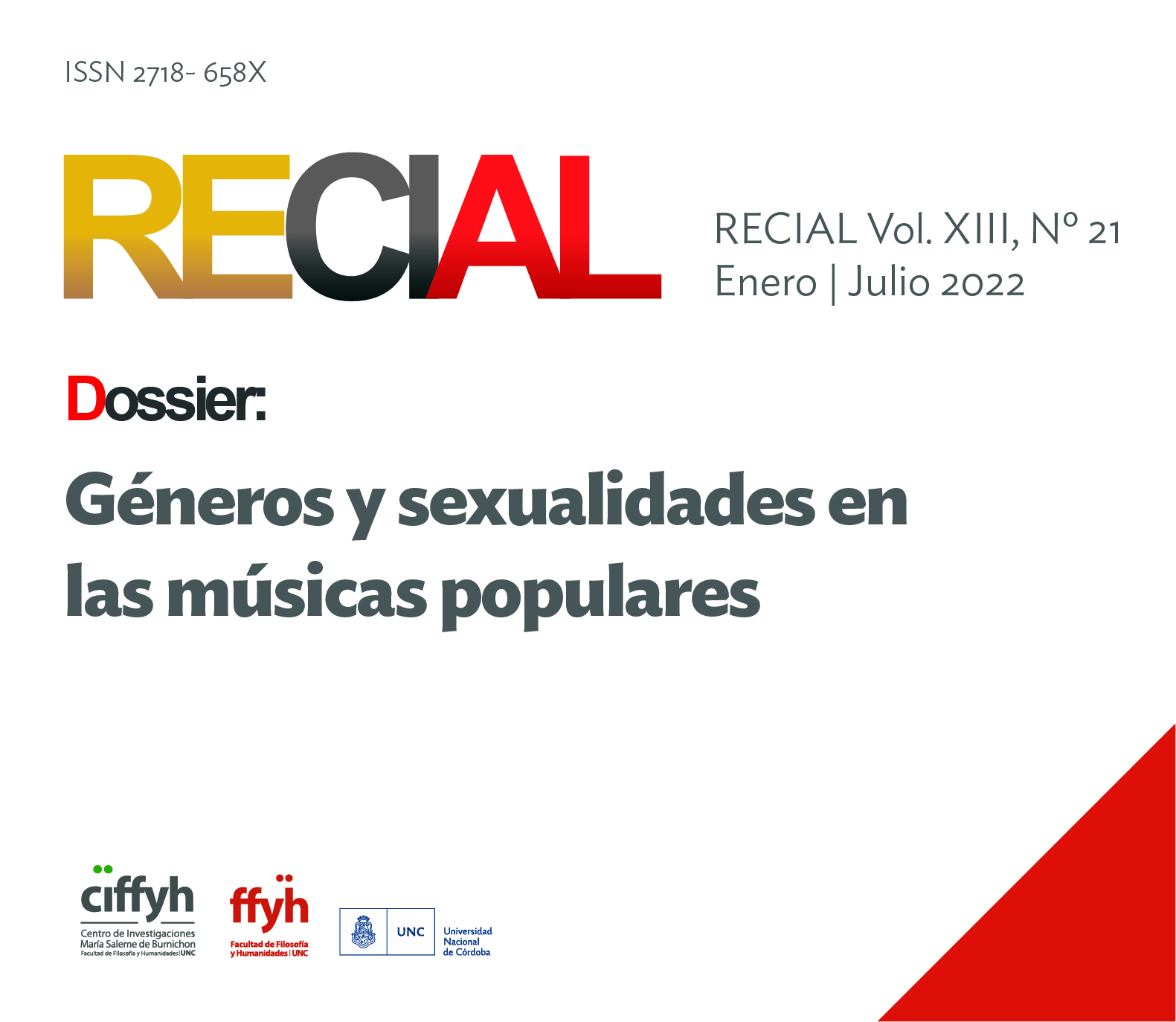Hybrid masculinities in Måneskin's glam rock
DOI:
https://doi.org/10.53971/2718.658x.v13.n21.37844Keywords:
glam rock, masculinity, Måneskin, authenticity, Eurovision Song ContestAbstract
The Italian rock group Måneskin was awarded in Eurovision Song Contest´ 2021. Since then, its global audience was growing up and its impact has been remarkable, even entering the Billboard charts. Måneskin were labled as glam rock, genre well-known for its inauthenticity and its challenge to rock´s heteronormativity through androgyny, transvestism, and the understanding of gender as a performance, features came up from camp and effeminate masculinity linked with gay. In this research, we make a brief approach to Måneskin´s gender discourse, applying the concept defined, among others, by Bridges and Pascoe of “hybrid masculinity”. In first section we examine how, despite its glam features, Måneskin articulate a discourse focused on rock authenticity strategies, which are related to masculinity and homosociality. For this analysis, we took specially into account Måneskin´ performance of Zitti e buoni in ESC. Second, we examine hybrid masculinity in Måneskin through its singer Damiano David, its bassist Victoria de Angelis, and I wanna be your slave video. Thus, we highlighted how Måneskin's hybrid masculinity shows the negotiations in which masculinity is currently inserted.
Downloads
References
Arenillas Meléndez, S. (2020). Discursos, identidades y transgresión en la música popular española (1980-2010): El caso del glam rock y sus variantes. Madrid: Sociedad Española de Musicología.
Auslander, P. (1999). Tryin´ to make it real: Live performance, simulation, and the discourse of authenticity in rock culture. En Autor, Liveness: Performance in a mediatized culture (pp. 73–127). New York: Routledge.
Auslander, P. (2006). Performing glam rock: Gender and theatricality in popular music. Ann Arbor: University of Michigan Press.
Baker, C. (2008). Wild dances and dying wolves: Simulation, essentialization, and national identity at the Eurovision Song Contest. Popular Communication, 6(3), 173–189.
Baker, C. (2016). The ‘gay Olympics’? The Eurovision Song Contest and the politics of LGBT/European belonging. European Journal of International Relations, 23(1), 97–121.
Biddle, I., y Gibson, K. (Eds.). (2009). Masculinity and Western musical practice. Farnham: Ashgate.
Boise, S. de (2012). Masculinities, music, emotion and affect (Tesis doctoral). Universidad de Leeds, Leeds.
Boise, S. de (2015). Man, masculinity, music and emotions. Basingstoke: Palgrave Macmillan.
Bolin, G. (2006). Visions of Europe: Cultural technologies of nation-states. International Journal of Cultural Studies, 9(2), 189–206.
Branch, A. (2012). All the young dudes: Educational capital, masculinity and the uses of popular music. Popular Music, 31(1), 25–44.
Bridges, T., y Pascoe, C. J. (2014). Hybrid masculinities: New directions in the sociology of men and masculinities. Sociology Compass, 8(3), 246–258.
Cagle, V. M. (1995). Reconstructing pop/ subculture: Art, rock and Andy Warhol. Thousand Oaks: Sage Publications.
Cagle, V. M. (2000). Trudging through the Glitter trenches: The case of the New York Dolls. En S. Waldrep (Ed.), The Seventies. The Age of Glitter in popular culture (pp. 125–151). New York, London: Routledge.
Calvo, M. (2020). Masculinidades y feminidades en la música metal. Con X, 6, 2–28.
Clawson, M. A. (1999a). Masculinity and skill acquisition in the adolescent rock band. Popular Music, 18(1), 99–114.
Clawson, M. A. (1999b). When women play the bass: Instrument specialization and gender interpretation in alternative rock music. Gender & Society, 13(2), 193–210.
Cleto, F. (Ed.). (1999). Camp: Queer aesthetics and the performing subject. Ann Arbor: University of Michigan Press.
Coates, N. (1997). (R) Evolution now?: Rock and the political potential of gender. En S. Whiteley (Ed.), Sexing the groove: Popular music and gender (pp. 50–64). London: Routledge.
Connell, R. W. (1995/2002). Masculinities. Berkeley: University of California Press.
Davies, H. (2001). All rock and roll is homosocial: The representation of women in the British rock music press. Popular Music, 20(3), 301–319.
Dyer, R. (1999). It´s being so camp as keeps us going. En F. Cleto (Ed.), Camp: Queer aesthetics and the performing subject (pp. 110–116). Ann Arbor: University of Michigan Press.
Fairclough, N. (1992). Discourse and social change. Oxford: Polity.
Fricker, K., y Gluhovic, M. (Eds.). (2013). Performing the “New” Europe: Identities, feelings and politics in the Eurovision Song Contest. London: Palgrave Macmillan.
Green, L. (1997). Music, gender and education. Cambridge: Cambridge University Press.
Gregory, G. (2002). Masculinity, sexuality and the visual culture of glam rock. Culture and communication, 5(2), 35–60.
Grossberg, L. (1992). Rock, posmodernity and authenticity. En Autor, We gotta get out of this place: Popular conservatism and postmodern culture (pp. 201–239). London, New York: Routledge.
Hansen, K. A. (2022). Pop masculinities: The politics of gender in twenty-first century popular music. New York: Oxford University Press.
Harrison, S. (2008). Masculinities and music: Engaging men and boys in making music. Newcastle: Cambridge Scholars Publishing.
Hawkins, S. (2009). The British pop dandy: Masculinity, popular music and culture. Farnham: Ashgate.
Hawkins, S. (Ed.). (2017). The Routledge research companion to popular music and gender. Oxford, New York: Routledge.
Häyhtiö, T., y Rinne, J. (2007). Hard rock Hallelujah! Empowering reflexive political action on the internet. Journal for Cultural Research, 11(4), 337–358.
Inglis, I. (2007). “Sex and drugs and Rock’n’Roll”: Urban legends and popular music. Popular Music and Society, 30(5), 591–603.
Kalman, J., Wellings, B., y Jacotine, K. (Eds.). (2019). Eurovisions: Identity and the international politics of the Eurovision Song Contest since 1956. Singapore: Palgrave Macmillan.
Kurennaya, A. (2012). Look what the cat dragged in: Gender, sexuality, and authenticity in 1980s glam metal (Tesis de maestría). Parsons the New School for Desing, New York.
Leibetseder, D. (2012). Queer tracks: Subversive strategies in rock and pop music. Farnham: Ashgate.
López Castilla, M. T. (2015). Música electrónica y cultura de club: un estudio postfeminista de la escena española (Tesis doctoral). Universidad de La Rioja, La Rioja.
Maglov, M. (2016). Musical genre as an indicator of the unity in diversity concept: Case study of the ESC’s winning song Hard Rock Hallelujah. ART+MEDIA Journal of Art and Media Studies, 10, 59–65.
Måneskin. (22 de mayo de 2021). Måneskin - Zitti E Buoni - Italy?? - Grand Final - Eurovision 2021 [Video]. Youtube. Recuperado de https://www.youtube.com/watch?v=RVH5dn1cxAQ
Måneskin. (23 de mayo de 2021). Eurovision2021 winner måneskin: rock-n-roll never dies! [Video]. Youtube. https://www.youtube.com/watch?v=v2iVCyD9Npc
Måneskin: este el resultado del test de drogas de su cantante, acusado de consumir cocaína en Eurovisión. (25 de mayo de 2021). Rock Fm. Recuperado de https://www.rockfm.fm/al-dia/noticias/maneskin-este-resultado-del-test-drogas-cantante-acusado-consumir-cocaina-eurovision-20210525_1307395.
Måneskin. (15 de julio 2021). Måneskin - I WANNA BE YOUR SLAVE (Official Video) [Video]. Youtube. https://www.youtube.com/watch?v=yOb9Xaug35M
Måneskin. (23 de enero de 2022). Måneskin: I Wanna Be Your Slave (Live) - SNL [Video] Youtube. https://www.youtube.com/watch?v=59MJbfNTUXs
Mariskalrock.com (mayo de 2021). maneskin-2021-eurovision [Imagen]. Recuperado de https://mariskalrock.com/wp-content/uploads/2021/05/maneskin-2021-eurovision.jpg.
Martínez García, S. (2003). Decibelios y testosterona: una aproximación a las imágenes de género del rock y el heavy. Dossiers Feministes. No me arrepiento de nada: Mujeres y música, 7, 101–118.
McClary, S. (1991). Feminine endings: Music, gender, and sexuality. Mineápolis: University of Minnesota Press.
Meyer, M. (Ed.). (1994). The politics and poetics of camp. London: Routledge.
Moore, A. F. (2002). Authenticity as authentication. Popular Music, 21(2), 209–223.
Paul, J. (2014). The modern fairy tale: Nation branding, national identity and the Eurovision Song Contest in Estonia. Tartu: University of Tartu Press.
Pedro, J., Piquer Sanclemente, R. y Val Ripollés, F. del. (2018). Repensar las escenas musicales contemporáneas: genealogía, límites y aperturas. Etno: Cuadernos de etnomusicología, 12, 63–88.
Peterson, R. A., y Bennett, A. (2004). Music scenes: Local, translocal, and virtual. Nashville: Vanderbilt University press.
Philo, S. (2018). Glam rock: Music in sound and vision. Lanham: Rowman & Littlefield.
Pillonetto, I. (29 de mayo de 2021). Måneskin, los nuevos reyes del “glam.” Europa FM. Recuperado de https://www.europafm.com/noticias/musica/mneskin-nuevos-reyes-glam_2021052960b1e75672f188000157b761.html
Rehberg, P. (2013). Taken by a stranger: How queerness haunts Germany at Eurovision. En K. Fricker y M. Gluhovic (Eds.), Performing the “New” Europe: Identities, feelings and politics in the Eurovision Song Contest (pp. 163–177). London: Palgrave Macmillan.
Reynolds, S. (2011). Retromania: Pop culture´s addiction to its own past. London: Faber and Faber.
Reynolds, S. (2016). Shock and awe. Glam rock and its legacy, from the seventies to the twenty-first century. New York: Faber and Faber.
"Si dice Måneskin, non Moleskine!": origine e significato del nome della band (12 de diciembre de 2017). Sky It. Recuperado de https://xfactor.sky.it/info/maneskin-non-moleskine-x-factor-2017.
Unterberger, A. (7 de agosto de 2021). Måneskin. With a Eurovision win and a viral cover smash, the Italian rock group has fans “Beggin’” for more. Billboard, 72.
Waksman, S. (1999). Instruments of desire: The electric guitar and the shaping of musical experience. Cambridge: Hardvard University Press.
Walser, R. (1993). Forging masculinity: Heavy metal sounds and images of gender. En Autor, Running with the devil: Power, gender and madness in heavy metal music (pp. 108–136). Hanover: University Press of New England.
Weinstein, D. (2009). The empowering masculinity in British heavy metal. En G. Bayer (Ed.), Heavy metal music in Britain (pp. 17–31). Farnham: Ashgate.
Whiteley, S. (Ed.). (1997). Sexing the groove: Popular music and gender. London: Routledge.
Wood, E. (1994). Sapphonics. En P. Brett, G. Thomas, y E. Wood (Eds.), Queering the pitch: The new gay and lesbian musicology (pp. 27–66). New York: Routledge.
Yuste, M. (25 de mayo de 2021). El triunfo de Damiano David en Eurovisión es también el de la nueva masculinidad en el mainstream. Trendencias. Recuperado de: https://www.trendencias.com/general/triunfo-maneskin-eurovision-tambien-nueva-masculinidad-mainstream
Downloads
Published
Issue
Section
License

This work is licensed under a Creative Commons Attribution-NonCommercial-ShareAlike 4.0 International License.
Aquellos/as autores/as que tengan publicaciones en esta revista, aceptan los términos siguientes:
- Los/as autores/as conservarán sus derechos de autor y garantizarán a la revista el derecho de primera publicación de su obra, el cuál estará simultáneamente sujeto a la Licencia de reconocimiento de Creative Commons que permite a terceros compartir la obra siempre que se indique su autor y su primera publicación esta revista.
- Los/as autores/as podrán adoptar otros acuerdos de licencia no exclusiva de distribución de la versión de la obra publicada (p. ej.: depositarla en un archivo telemático institucional o publicarla en un volumen monográfico) siempre que se indique la publicación inicial en esta revista.
- Se permite y recomienda a los/as autores/as difundir su obra a través de Internet (p. ej.: en archivos telemáticos institucionales o en su página web), luego de su publicación en la revista. (Véase El efecto del acceso abierto).























